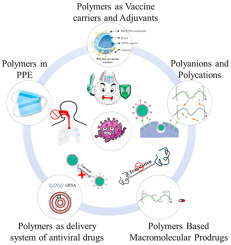Towards the Prevention of Coronavirus Infection: What Role Can Polymers Play?

Severe Acute Respiratory Syndrome associated coronavirus 2 (SARS-CoV-2) has caused a global public health crisis with high rates of infection and mortality. Treatment and prevention approaches include vaccine development, the design of small molecule antiviral drugs and macromolecular neutralizing antibodies. Polymers have been designed for effective virus inhibition and as anti-viral drug delivery carriers.. This review summarizes recent progress and provides a perspective on polymer based approaches for the treatment and prevention of coronavirus infection. These polymer-based partners include polyanion/polycations, dendritic polymers, macromolecular prodrugs and polymeric drug delivery systems that have the potential to significantly improve the efficacy of antiviral therapeutics.
Introduction
Severe acute respiratory syndrome associated coronavirus 2 or SARS-CoV-2 belongs to the β family of coronaviruses and infects humans by the fusion of viral and cell membranes, facilitated by binding between the SARS-CoV-2-related spike (S) protein and angiotensin-converting enzyme 2 (ACE2). The β coronavirus family is also responsible for the common cold, severe acute respiratory syndrome coronavirus (SARS-CoV) and Middle East respiratory syndrome associated coronavirus (MERS-CoV). Strategies to reduce coronavirus infection includes wearing masks, small molecule drugs, vaccines, neutralizing antibodies, RNA interference therapy and other mitigation factors. These treatment methods span in vitro prevention to in vivo treatment, including blocking the spread of the virus, inhibiting the translation of viral RNA in host cells, activating the immune system and inhibiting the expression of S protein gene.) Some of these interventions, however, would benefit from a polymer “modulator” to improve efficacy.
There has been some work in literature that describes disinfection as well as anti-microbial materials. Recently, polymer materials have demonstrated antiviral capabilities. As shown in figure 1, polymers can prevent or inhibit the spread of a virus by: (i) providing a semi-permeable barriers (e.g. mask or face-shield); (ii) interfering with binding to the glycoprotein surface of host cells; (iii) augmenting small molecular anti-viral drug therapies; (iv) enhancing the response of the immune system as a vaccine adjuvant; or (v) as a vehicle for other therapeutic molecules to improve the water solubility or stability of anti-viral therapeutics. Based on the structural characteristics and uses of the above polymers, this review will summarize recent polymeric anti-viral approaches based on polyanion/polycation, dendritic polymer, macromolecular prodrugs, and polymer-based delivery system, as well as provide a short perspective of polymeric approach towards the treatment of new type of coronavirus.


